Heat-loving grapes are grown everywhere today, propagating varieties and hybrid forms of culture. For planting, seedlings are purchased in nurseries or use cuttings. Growing grapes from the cuttings at home is troublesome, but gardeners do not stop the difficulties. Thanks to their own planting material, plants that are more resistant to local climatic conditions are obtained. In addition, full-grown seedlings of a favorite variety are grown in this way.
Content
- 1 Features of growing grapes by cuttings
- 2 Growing grape cuttings
- 3 Planting grape cuttings in glasses or pots
- 4 Care of planted cuttings
- 5 Diseases and methods for their treatment
- 6 Planting cuttings in a greenhouse, greenhouses or open ground
- 7 The specifics of growing grapes by cuttings in different regions
- 8 Reviews
- 9 Conclusion
Features of growing grapes by cuttings
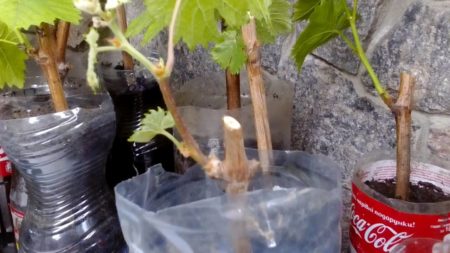 When planning planting, take into account the climate of the region. In the south, various, including late grape varieties are suitable for cultivation. In the conditions of the middle zone of Russia, the Moscow region, the regions of the North-West and further to the north, they select a culture of early ripening. In the south, grapes can be planted with cuttings in the fall; in spring, seedlings will quickly grow.
When planning planting, take into account the climate of the region. In the south, various, including late grape varieties are suitable for cultivation. In the conditions of the middle zone of Russia, the Moscow region, the regions of the North-West and further to the north, they select a culture of early ripening. In the south, grapes can be planted with cuttings in the fall; in spring, seedlings will quickly grow.
In addition to the growing season, pay attention to the frost resistance of the variety, resistance to diseases and infections. In areas with a short summer, it is recommended to plant a capricious "southerner" in greenhouses. Take into account that in closed ground there is a high risk of grape damage by fungal diseases. But the greenhouse method of growing will allow you to collect good harvests of berries and enjoy their taste.
Growing grape cuttings
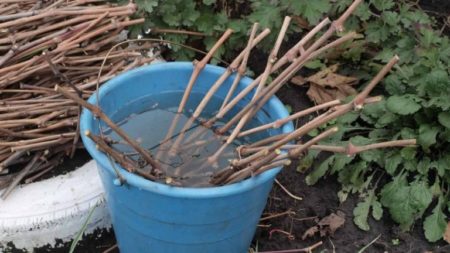 Growing grape cuttings is not so difficult, methods are available even for beginner growers. Compliance with certain techniques of agricultural technology, care and maintenance - these are the main things that culture requires.
Growing grape cuttings is not so difficult, methods are available even for beginner growers. Compliance with certain techniques of agricultural technology, care and maintenance - these are the main things that culture requires.
Cutting cuttings
First, let's define the terminology. Cuttings (or chubucks) are called part of the grape shoot with several buds. To obtain planting material in the fall, they start cutting shoots. Duration of the procedure - after the leaves fall completely from the bushes. Useful recommendations:
- shoots are selected for cutting, which gave the biggest clusters of berries in a season.
- it is advisable to choose straight, without twisting twigs;
- cuttings are cut only at positive air temperature.
For cuttings suitable two-year branches, without spots, defects of the bark. The optimum thickness is 0.7-1 cm, but the parameters depend on the characteristics of the variety. There are grape varieties that originally had thin vines.
Choose healthy bushes with characteristics characteristic of a particular variety. Chubuk length is determined by the number of kidneys. The most suitable ones are with two or three eyes, although shoots with one or four buds take root well.
Cut the cuttings, following certain rules:
- the lower cut is done obliquely, slightly departing from the lower kidney;
- the upper cut is straight, a distance of 3-4 cm is left above the eye.
Thanks to different cuts, it is later easy to figure out where the chubuk has the top, and where is the lower part. Sometimes gardeners cut the vine into long sections - 60-120 cm, and in the spring they divide them into cuttings.
After cutting, the shoots are tied according to grades, labeled, processed and laid on storage.
Storage
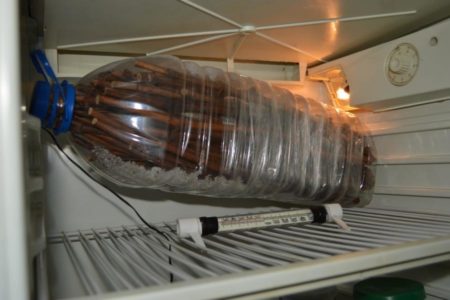 For storage fit:
For storage fit:
- refrigerator shelf (if there are not a lot of cuttings);
- dry basement;
- a plot in the country where the cuttings are laid in trenches and covered until spring.
In a region with snowy winters, it is convenient to store in snowdrifts.
Before laying, the Chubuki are prepared for wintering:
- Soak in basins or flat containers with water, laying shoots horizontally. Water should lightly cover the plants. The term is one day.
- Then soak for 5-10 minutes in a pink solution of potassium permanganate or vitriol (300 grams per bucket of water).
- They are dried.
- Wrap in cling film.
For better preservation, some gardeners paraffin sections of shoots. Instead of storage film, ordinary plastic bottles will do.
Storage temperature: from 0 to + 5ºC, if it is higher, the kidneys will begin to swell. Chubuki stack, without mixing, in bundles of varieties.
During storage, the Chubuki periodically check. Having discovered that the buds swell on the shoots, they lower the temperature. To do this, grapes are removed to a colder place (in the basement), transferred to another, colder shelf in the refrigerator.
When wintering in a snowdrift until snow falls, grapes are kept in bundles in burlap. As soon as the first frosts strike, the ligaments are transferred to the basement. After snowfall, the shoots are packed in white bags of sugar, in plastic bottles and buried in snowdrifts. The depth of snow cover above should be at least 50 cm.
Preparation for landing
Grape cuttings well preserved after wintering quickly take root. Before planting, inspect all specimens, throwing away diseased or damaged shoots.
- Inspect the bark of cuttings. It should not have dark spots, rot, deformation.
- Neatly cut the stem across. If the cut is brown or black, then the stalk is not suitable for planting. For high-quality chubuk, the cut is light green, slightly moist. Moisture should be a little, a few drops.
After examining the cuttings, you need to "wake up". This is done to revitalize plant tissues, prepare for germination.
Grapes are placed in shallow containers with warm water for 1.5-2 days. After this, the shoots are immersed in a solution with a rooting agent for a few more hours.
Gardeners with experience plant cuttings without preliminary germination, immediately in pots with soil. But there is a risk that cuttings without roots will not take root. For insurance, it is recommended to first sprout Chubuki, and only then, with roots, planted in pots.
Germination
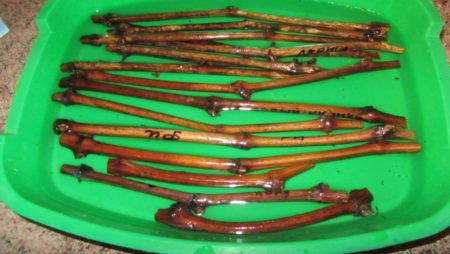 To awaken the roots, different methods are used:
To awaken the roots, different methods are used:
- germination in water;
- germination in wet sawdust.
Long vines are preliminarily cut into cuttings, then several scratches are applied with a knife at the bottom of the cuttings. Callus flows on the stem, which contributes to the rapid formation of roots.
The first germination option is standard:
- In any container with a volume of 1 liter (bottle, glass jar), a little melt water is poured, a layer of 5-6 cm.
- Place the cuttings in a container.
- The upper cut of the shoots is covered with garden varieties.
The jar is put on the windowsill, covered with a transparent bag on top to obtain a "greenhouse" effect. To disinfect, add a couple of tablets of activated carbon to the water.
Temperature indicators: + 25ºC ... + 30ºC - near the roots, + 10ºC - in the upper part, near the kidneys. This difference is necessary in order for the seedlings to produce roots first, and only then the buds will open. Thanks to wilderness, the risk of death of cuttings is reduced, and the chance of rapid rooting increases.
In addition to heat, grapes need enough light. The best place is near the window, you only need to put a screen (cardboard, cloth) to protect against cool air flows.
The second method: germination in sawdust. For this:
- Pour a layer of sawdust (5-6 cm) into the container.
- Gently spill the sawdust with warm water.
- Shoots are placed in a container and another layer of sawdust is added.
- From time to time, the layer is moistened, waiting for the roots to appear.
Only high-quality sawdust previously steamed with boiling water is suitable for germination.
Planting grape cuttings in glasses or pots
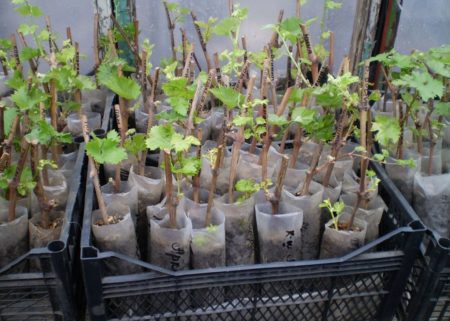 In the midland and northern regions, after germination, grapes are planted in prepared glasses or pots with soil.
In the midland and northern regions, after germination, grapes are planted in prepared glasses or pots with soil.
Suitable containers:
- cardboard glasses;
- cut plastic bottles (1-1.5 liters).
Be sure to pierce holes in the bottom to exit excess moisture. For drainage, broken brick, expanded clay, calcined small pebbles are used.
Soil is prepared in advance by mixing fertile turfy soil and river sand (1: 1). Ready-made soil mixes from the store are suitable, in which for friability add calcined river sand, perlite. When to plant? Around March, 2-2.5 months before landing at a permanent place.
Place the seedling in a pot, sprinkle with soil and slightly moisten. It is advisable to determine one cuttings in each container, so the grapes will be free. Chubuki with two eyes are planted, completely digging the kidneys into the nutrient mixture (the top should only “peep” slightly above the ground). In seedlings with three eyes, one bud should be in the ground, the second near the surface of the soil, the third above the ground.
The plants without leaves planted in glasses or pots are covered with a plastic bag on top. If there are leaves, dispense with cover package.
Care of planted cuttings
Follow-up care for ordinary grape bushes:
- watering;
- loosening;
- maintaining optimal temperature;
- proper lighting.
Stagnation of water in tanks is excluded, but at the same time the soil should not dry out. Irrigate the soil regularly, controlling humidity. In city apartments, with the heating turned on, the air is dry, which negatively affects the growth of cuttings. In order to ensure a comfortable microclimate, water cans are installed near the grapes. Watered with warm, settled water, slightly above room temperature.
If the plants from above were covered with a plastic bag, then they remove it gradually, accustoming the plants to open air. In the first weeks, seedlings do not need too much light, but after unfolding the leaves, additional lighting is arranged.
Recommend to use:
- fluorescent lamp;
- LED lights.
Temperature: + 25ºC ... + 27ºC, but even if the indicators are slightly less, it's okay.
About 30-40 days after planting the sprouted seedlings, the grapes are fed. A complex mineral fertilizer (azofoska, nitrofoska), the composition for Novofert grapes is suitable.
About 18-20 days before the alleged transplantation, the plants are hardened into the ground. To do this, the grapes are taken out to the balcony, terrace, to the veranda. First, the stay is limited to 20-40 minutes, then leave the seedlings in pots for a day. When warm days begin, they leave the plants for the night, and then, in late May or early June, they are planted in the ground.
Diseases and methods for their treatment
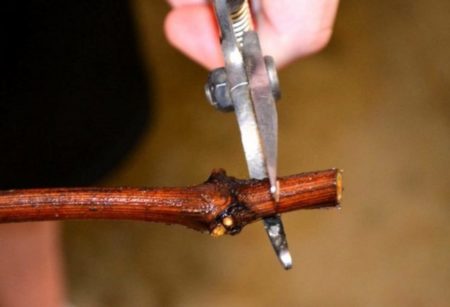 Get healthy grape seedlings is possible only with proper and proper care. It is important to use healthy bushes that are not affected by fungal infections for slicing.
Get healthy grape seedlings is possible only with proper and proper care. It is important to use healthy bushes that are not affected by fungal infections for slicing.
In order to avoid diseases, cuttings are treated before laying for winter storage, as well as before planting in pots. Of the drugs suitable:
- foundationazole;
- rover.
Some gardeners treat chopped cuttings with a pink solution of potassium permanganate.Treatment with drugs will protect the planting material from dangerous microorganisms, to avoid the occurrence of foci of the disease during storage.
For the same purpose, when germinating, activated carbon, wood ash are added to the water with cuttings. If cuttings sprout in a substrate of sawdust, then once a week it is useful to spray them with a solution of Rovral.
When growing grapes from cuttings, observe the leaves. If the leaf blades begin to change color, turn yellow, this is a signal about the possible occurrence of a dangerous mildew infection. Bordeaux mixture is prepared promptly and cuttings are treated. Instead of Bordeaux liquid, you can use the drug Ridomil Gold.
With waterlogging or lack of moisture, the leaves turn black. The same thing happens in situations if the soil for seedlings is incorrectly selected (too dense structure). Exit: immediately change the soil in pots, adjust the regime of watering plants.
Planting cuttings in a greenhouse, greenhouses or open ground
Not every gardener can grow grape cuttings at home. In the middle lane the green "garden" is transferred to the greenhouse. In the south, cuttings are planted immediately in the ground.
Planting in pots in a greenhouse or greenhouse
The main work begins in late February. The activities are the same as when growing cuttings in the apartment:
- inspection of cuttings;
- disinfection;
- if necessary, cutting a long vine;
- germination.
The process of rooting in water is sometimes replaced by planting cuttings in a greenhouse in wet sand. At the same time, the air temperature should be at least + 12ºC, and even better if higher. These indicators are the best possible for root formation. Therefore, if the greenhouse fails to provide the necessary conditions, the cuttings are grown at home.
With proper treatment, after about 19-21 days, the roots of roots appear, the kidneys swell. When roots grow by 2-3 cm, seedlings are transplanted from sand into special pots with soddy soil.
The temperature in the greenhouse is not lower than + 24ºC ... + 25ºC, and humidity is controlled. When growing on the handle, several shoots leave the strongest, the rest are plucked. As soon as he reaches a height of 50-60 cm, pinch him. Such cuttings root better in a permanent place and grow well.
Landing - end of May or beginning of June. Pre-grapes are prepared for new conditions, leaving the doors of the greenhouse and windows open.
Landing
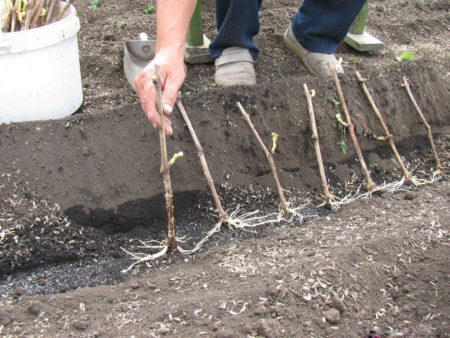 For grape cuttings, a well-lit, closed from the winds place is chosen on the site. Prepare small holes in advance, humus.
For grape cuttings, a well-lit, closed from the winds place is chosen on the site. Prepare small holes in advance, humus.
How to plant seedlings without stress for plants? Cuttings are carefully removed from pots or cups, together with an earthen lump set in pits. They add soil, humus, slightly irrigate and slightly compact the earth around. At the same time, a stake is placed nearby to support the plant.
The specifics of growing grapes by cuttings in different regions
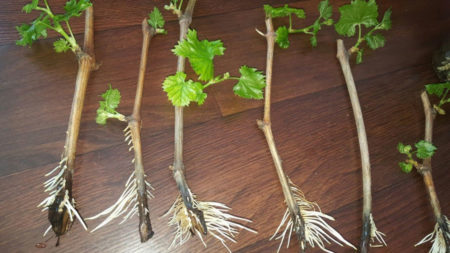 The process of growing planting material varies greatly depending on the climatic conditions of the region. If in the most southern regions they are rarely associated with growing seedlings at home, then in the north it cannot be otherwise.
The process of growing planting material varies greatly depending on the climatic conditions of the region. If in the most southern regions they are rarely associated with growing seedlings at home, then in the north it cannot be otherwise.
Southern regions (Kuban, Krasnodar Territory)
These regions receive rich harvests of delicious grapes. Growing grapes from cuttings is practiced, while plants are planted immediately in open ground. Popular ways:
- autumn landing "long vine";
- landing in the spring in the well ("ramrod").
On the fertile chernozems of the Kuban, cuttings quickly take root, go to growth and subsequently please growers with excellent crops.
Moscow region
how grow grapes from cuttings in the suburbs? The best way is to use heated greenhouses or at home.
The climate of the Moscow region is unpredictable, often in winter, severe cold replace the thaw. Recommended varieties of early vegetation, with high rates of resistance to frost.
Only sprouted grape cuttings are planted in pots, provide complete care. Plants are detected in open ground not earlier than June 10-15, when the threats of dangerous return frosts pass.
Belarus
Many grape varieties are successfully growing in Belarus. They grow crops from cuttings most often at home, sometimes in greenhouses. The climate in most of the territory is mild, winters are usually warm. But in the summer there may not be enough warm days, so it is recommended to choose varieties with early ripening. Start germination of cuttings at the end of February, a permanent place in the ground is planted at the end of May.
Ural, Northwest
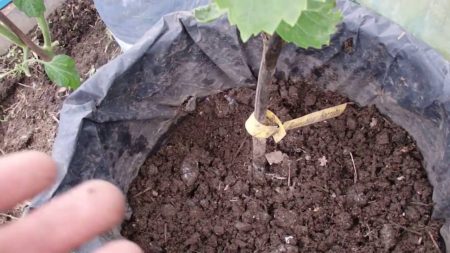 The main schemes and measures for the germination and planting of cuttings in these harsh regions are similar to those practiced in the suburbs. The difference in timing, after all, winters are long, frosty, stable, warm temperatures are not set earlier than the beginning of June. Therefore, after growing cuttings at home, plants are put in greenhouses or potted greenhouses for the whole summer.
The main schemes and measures for the germination and planting of cuttings in these harsh regions are similar to those practiced in the suburbs. The difference in timing, after all, winters are long, frosty, stable, warm temperatures are not set earlier than the beginning of June. Therefore, after growing cuttings at home, plants are put in greenhouses or potted greenhouses for the whole summer.
With good rapid growth and development of seedlings around mid-summer, they are neatly transferred to large containers (for example, five-liter cut plastic bottles, old buckets). Until September, seedlings grow in them, and then transplanted over summer plants grown in the ground.
Before the onset of cold weather, grapes are thoroughly spudded, reliably sheltered for the winter.
Reviews
Eugene, Moscow region
I usually harvest cuttings at the end of winter, I grow non-covering grapes. So it’s quite possible to do everything already in the last days of February or in early March. I chop it, then germinate it and immediately plant it in a greenhouse in a prepared "school". Then from there I determine to a permanent place, closer to mid-June. I’ve been growing cuttings like this all years, I have never regretted it.
Svetlana, Saratov
The first time four years ago, cuttings of different varieties were brought to me in the fall. They were with three kidneys. I identified them all in pots of earth and sand, covered it with a bag on top and put it in the basement. They were well kept, I constantly checked and slightly moistened the ground. At the beginning of March, they got grapes, the kidneys were already slightly swollen, put everything out on the windows. And already in April they transported them to the country house and put them in a greenhouse. There, they safely survived until the summer, and I transplanted them to the beds. Now I just do this if you need to grow a certain variety. Breeding with cuttings is simpler and more profitable than buying seedlings in the nursery all the time.
Conclusion
It is not so difficult to grow the cuttings of the desired grape variety even in the middle zone or in the Urals. Suitable for growing in an apartment, in a greenhouse, in a greenhouse. Providing the right agricultural technology, after a couple of years from their own seedlings get excellent yields.




 Non-covering winter-hardy grape varieties for Moscow region
Non-covering winter-hardy grape varieties for Moscow region How to keep the vine in winter
How to keep the vine in winter When can I transfer grapes to another place in the fall
When can I transfer grapes to another place in the fall How to cover and prepare grapes for the winter in the suburbs
How to cover and prepare grapes for the winter in the suburbs